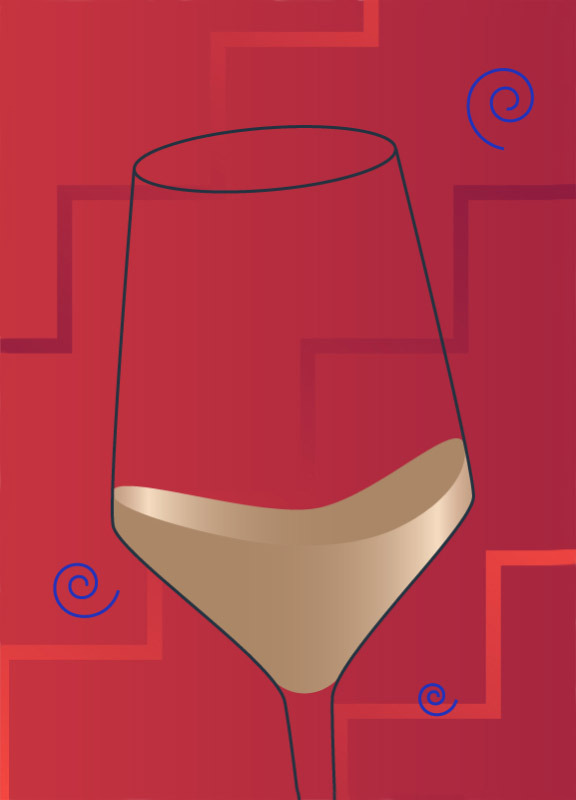Be honest: how many times have you bought a bottle of wine simply because you thought the label was pretty – and then didn’t even like the taste of the wine? Don’t worry, it can happen to anyone. But with a few simple steps and a bit of background knowledge, you can discover your own personal taste in wine. Read on to find out how. And once you’ve discovered what you really like, pay a visit to your favorite winery. Our Rhineland-Palatinate winemakers and wine merchants are happy to advise you – and it always tastes better right from the source.

Red wine, white wine, and their characteristics
More than 40 different grape varieties are grown in Rhineland-Palatinate alone. The wines pressed from them are as diverse as our six wine-growing regions: their taste ranges from light and fruity to full-bodied and heavy, their color nuances from shimmering pale yellow to deep, dark red. And thanks to our wide variety of soil compositions, every Rhineland-Palatinate wine scores points with a highly individual flavor profile.

Light and fruity
Their uncomplicated aroma is often reminiscent of red fruits like strawberries or cherries. Light red wines have a low tannin content, i.e. they contain a low proportion of herbal tanning agents.

Medium-bodied and tangy
The aromas of spices and dark fruits such as plums make up the composition of medium-bodied red wines. Their fuller body can be traced to a higher tannin content.

Full-bodied and robust
Their high tannin and alcohol content makes these red wines delicious heavyweights. Complex aromas with notes of wood, dark fruits, and spices such as clove and pepper ensure a bold taste.

Light and fresh
With their crisp acidity and aromas of green apple and citrus fruits, these white wines offer uncomplicated enjoyment – and they taste best slightly chilled, of course.

Medium-bodied and fruity-floral
Complex aromas of peach and tropical fruits, subtle floral notes, and a fine balance of sweetness and acidity – no wonder medium-bodied white wines are so popular.

Full-bodied and creamy
Notes of vanilla and butter give full-bodied white wines their smooth warmth. Aromas of yellow apple and pear ensure a fruity sweetness.
Quality designations of German wine
Not all wines are the same – German wines are categorized into a total of three quality levels. This has little to do with taste, by the way: the categories are based on origin, the sugar content of the grapes (must weight), and the yield. Wines of all three quality levels are cultivated here in Rhineland-Palatinate.
The simplest quality designation. For a wine to be considered German wine, white and/or red grapes from anywhere in Germany can be used. That’s why the official category is simply “German wine,” without any further geographic information. Names of places or growing regions are not allowed to be mentioned on the label. Information about the varieties of grape is limited: common grape varieties such as Grauburgunder or Riesling are not allowed to be mentioned.
The grapes used for Landwein must come from a protected geographical area. The so-called “Landwein region” may be specified on the label – like a Palatinate Landwein, for example. The requirements for the ripeness of the grapes (must weight) are higher than those for German wine. The wines should be fruity, fresh, and typical of their region. The grape varieties may be specified on the label. The taste (residual sugar content) is usually dry to medium-dry.
Wines with protected designation of origin include German Qualitätswein (quality wine) and Prädikatswein (superior quality wine). These wines come entirely from a single specific growing region, such as Rheinhessen or the Mosel region. They fulfill regulated, highly detailed requirements regarding the origin, ripeness, and processing of the grapes. Only Qualitätswein and Prädikatswein may bear the name of smaller geographical areas in addition to the growing region, such as the name of a city or town (e.g. Nierstein) or of an even smaller area (e.g. Niersteiner Hipping).
Before they are allowed to be sold, all wines are tasted by an expert committee. Only wines which pass this test of sensory quality may be designated as Qualitätswein or Prädikatswein.
The white wines are predominantly vinified as varietal wines, which reflect the specific characteristics of the various types of grape in their flavors of yellow fruits and minerals. A typical example of this is Riesling. Weißburgunder and Grauburgunder are often aged in wooden casks or barriques. They produce wines that are traditionally paired with food.
The red wines are vinified as both varietal wines – e.g. Spätburgunder – as well as cuvées. This often results in full-bodied wines with tangy and smoky flavors in addition to those of concentrated red fruit.
Prädikat wines originate from the same growing regions. However, it is not permitted to alter the natural alcohol content of these wines. The six Prädikat categories are: Kabinett, Spätlese, Auslese, Beerenauslese, Trockenbeerenauslese, and Eiswein. The must weight increases with each Prädikat category. Kabinett and Spätlese are often fruity-sweet white wines. From the Auslese category upwards, you’ll find traditional sweet fines which are often made from the Riesling grape. These were the wines that helped German wine achieve worldwide fame, and they can withstand extremely long storage times.
Recognizing a good wine
We could simplify the explanation here and tell you: if you like the taste of the wine, it’s a good one. Because in the end, personal taste will be the deciding factor as to whether we find the wine “pleasing” or “not so good.” There are, however, several objective criteria we can use to recognize good wine.
Further information can be found here:
Tourism and Experience
Investments
Make it in Rhineland-Palatinate
